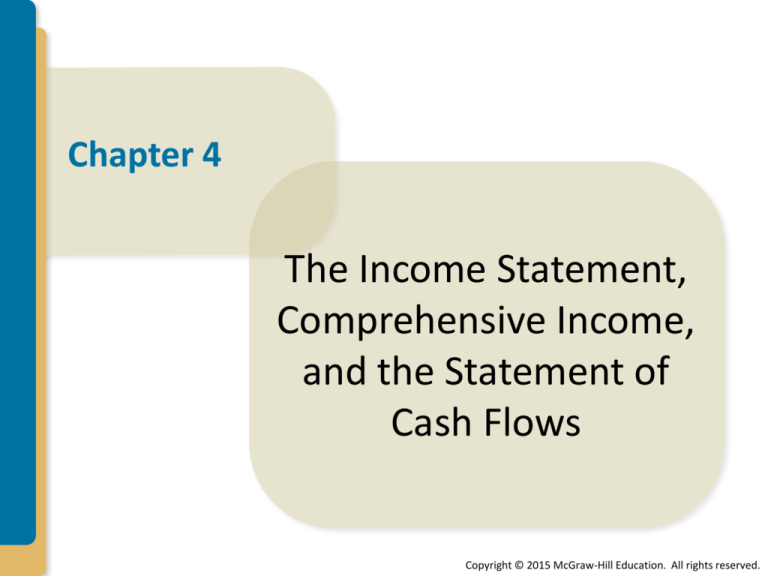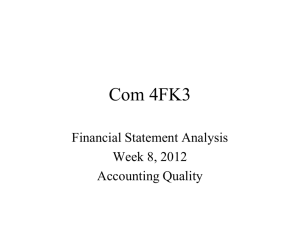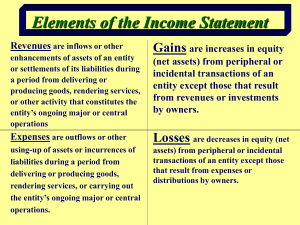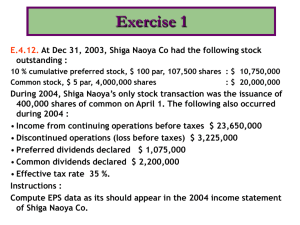
Chapter 4
The Income Statement,
Comprehensive Income,
and the Statement of
Cash Flows
Copyright © 2015 McGraw-Hill Education. All rights reserved.
The Income Statement, Comprehensive Income,
and the Statement of Cash Flows
Income Statement
(Statement of
Operations or
Statement of Earnings)
Displays a company’s
operating performance
Comprehensive Income
(other comprehensive
income (OCI) or loss)
Includes a few types of
gains and losses that are
not part of net income
Statement of Cash
Flows
Provides information
about cash receipts and
cash disbursements
The Income Statement, Comprehensive Income,
and the Statement of Cash Flows
Reports changes in shareholders’ equity
Income Statement
Change Statements
Statement of Cash Flows
Reports events that caused change in cash
Balance Sheet
Position Statement
LO4-1
Income from Continuing Operations
• Includes the revenues, expenses, gains, and losses
pertaining to transactions that probably will continue in
future periods
Revenues
• Inflows of resources resulting from providing
goods or services to customers
Expenses
• Outflows of resources incurred while generating
revenue
• Represent the costs of providing goods and
services
LO4-1
Recognition of Expenses
Causal relationship
Revenues
Yes
Expenses are
reported in the
same period that
the related
revenue is
recognized
Expenses
Is it possible to establish a
causal relationship
between revenues and
expenses?
No
Relate the expense
to a particular
period, allocate it
over several
periods, or
expense it as
incurred
LO4-1
Income from Continuing Operations
Gains and losses
• Increases or decreases in equity from peripheral
or incidental transactions of an entity
Examples
Gains and losses from the routine sale of
equipment, buildings, or other operating assets
and from the sale of investment assets
LO4-1
Income from Continuing Operations
Partial Income Statements
(In millions, except earnings per share)
Years Ended June 30
2016
2015
Single-Step Income Statement
• Groups all revenues and gains together and all
expenses and losses together
LO4-1
Multiple-Step Income Statement
• Reports series of intermediate subtotals
Concept Check √
Which of the following captions would more likely be found in a single-step
income statement?
a. Total revenues and gains.
b. Gross profit.
c. Operating income.
d. All of these answers are incorrect.
A single-step income statement groups together all
revenues and gains.
LO4-2
Earnings Quality
• Ability of reported earnings (income) to predict a
company’s future earnings
Transitory earnings
Result from transactions
that are:
not likely to occur again in the
foreseeable future
likely to have a different impact
on earnings in the future
Permanent earnings
Result from transactions
that are likely to
continue in the future
There may be transitory earnings
effects included in income from
continuing operations
LO4-2
Manipulating Income and Income Smoothing
• Most executives prefer to report earnings that
follow a smooth, regular, upward path
‘bank’ their
earnings by
understating
$
Earnings
15%
15%
Instead of: 30%
Use the banked
profits to polish
results
0
Methods:
• Income shifting - “channel stuffing”
• Income statement classification - “big bath”
accounting
LO4-3
Partial Income Statement—GameStop Corp.
• The extraordinary classification has now been
eliminated from GAAP
LO4-3
Operating Income and Earnings Quality
Restructuring
Costs
Include costs associated with
shutdown or relocation of facilities or
downsizing of operations
Recognized in the period the exit or disposal
cost obligation actually is incurred
Examples
• Termination benefits payable to employees to be
terminated: To be accrued in the period(s) the employees
render their service
• Costs associated with closing facilities: Recognized when
services or goods associated with those activities are
received
LO4-3
Operating Income and Earnings Quality
Long-lived
asset
impairments
Any long-lived
asset
Tangible
Intangible
should have its balance reduced if there
has been a significant impairment of value
Examples of revenue issues affecting earnings
quality:
• A company loses a major customer that can’t be
replaced
• Premature revenue recognition due to pressure to
meet earnings expectations
LO4-3
Nonoperating Income and Earnings Quality
Gains and
losses
Sale of
investments
Current earnings
Significant
LO4-3
Nonoperating Income and Earnings Quality
Example:
In 2000: Stock market boom
Pro forma earnings:
– Management’s assessment of permanent earnings
– The Sarbanes-Oxley Act requires reconciliation
between pro forma earnings and earnings
determined according to GAAP
LO4-3
Income Statements (in part)—Intel Corporation
LO4-4
Discontinued Operations
• Disposal of component(s) that represents a
strategic shift that has, or will have, a major effect
on a company’s operations and financial results
• Reported separately, below income from continuing
operations
Discontinued
operations,
(expense)/
benefit
Discontinued operations,
netnet
of of
$xx$xx
tax tax
(expense)/
benefit
Concept Check √
The Cansela Baseball Bat Company reported income before taxes of
$375,000. This amount included a $75,000 loss on discontinued operations.
The amount reported as income from continuing operations, assuming a tax
rate of 40%, is:
a. $375,000.
b. $270,000.
c. $180,000.
d. $225,000.
[$375,000 (income before income taxes) + $75,000 (loss on
discontinued operations)] × [1.0 – 0.4 (tax rate)] = $270,000
LO4-4
Reporting Discontinued Operations
Income or loss from
operations of the
component
On disposal of the
component’s assets
When the
component has
been sold
From the beginning of
the reporting period to
the disposal date
Gain or loss on
disposal of the
component’s assets
When the
component is
considered held
for sale
From the beginning of
the reporting period to
the end of the
reporting period
An “impairment loss”
if the book value of
the component is
more than fair value
minus cost to sell
LO4-4
Discontinued Operations—
Gain on Disposal
The Duluth Holding Company has several operating divisions. In October 2016,
management decided to sell one of its divisions that qualifies as a separate component
according to generally accepted accounting principles. The division was sold on
December 18, 2016, for a net selling price of $14,000,000.
$14,000,000 On that date, the assets of
the division had a book value of $12,000,000
$12,000,000. For the period January 1 through
$4,200,000 The
disposal, the division reported a pretax loss from operations of $4,200,000.
company’s income tax rate is 40% on all items of income or loss. Duluth generated
after-tax profits of $22,350,000 from its continuing operations.
Duluth’s income statement for the year 2016, beginning with income from continuing
operations, would be reported as follows:
Income from continuing operations
$22,350,000
_
_
Discontinued operations:
Loss from operations of discontinued component $(2,200,000) × 40%
Income tax benefit
880,000
Loss on discontinued operations
(1,320,000)
Net income
$21,030,000
LO4-4
Discontinued Operations—Impairment Loss
The Duluth Holding Company has several operating divisions. In October 2016,
management decided to sell one of its divisions that qualifies as a separate component
according to generally accepted accounting principles. On December 31, 2016, the end
of the company’s fiscal year, the division had not yet been sold. On that date, the assets
of the division had a book value of $12,000,000
$12,000,000 and a fair value, minus anticipated cost
to sell, of $9,000,000
$9,000,000. For the year, the division reported a pre-tax loss from operations
of $4,200,000
$4,200,000. The company’s income tax rate is 40% on all items of income or loss.
Duluth generated after-tax profits of $22,350,000 from its continuing operations.
Duluth’s income statement for 2016, beginning with income from continuing
operations, would be reported as follows:
Income from continuing operations
$22,350,000
_
_
Discontinued operations:
Loss from operations of discontinued component $(7,200,000) × 40%
Income tax benefit
2,880,000
Loss on discontinued operations
(4,320,000)
Net income
$18,030,000
Concept Check √
On October 1, 2016, American Medical Inc. adopted a plan to discontinue its
generic drug division, which qualifies as a separate component of the business
according to GAAP regarding discontinued operations. The disposal of the
division was expected to be concluded by March 30, 2017. On December 31,
2016, the company's year-end, the following information relative to the
discontinued division was accumulated:
Operating loss for 2016
$195 million
Excess of book value over fair value, less costs to sell, at year-end 25 million
In its income statement for the year ended December 31, 2016, American
would report a before-tax loss on discontinued operations of:
a. $170 million.
b. $195 million.
c. $220 million.
d. All of these answers are incorrect.
$195 million operating loss plus a $25 million impairment loss.
LO4-4
Discontinued Operations Disclosure—Eastman
Kodak Company
Concept Check √
The Trident Corporation’s results for the year ended December 31, 2016,
include the following material items:
Sales revenue
Cost of goods sold
Selling and administrative expenses
Gain on sale of investments
Loss on discontinued operations
Restructuring costs
$8,200,000
4,800,000
2,000,000
300,000
1,200,000
280,000
Trident Corporation’s income from continuing operations before income
taxes for 2016 is:
a. $1,120,000.
b. $ 220,000.
c. $1,700,000.
d. $1,420,000.
$8,200,000 – 4,800,000 -2,000,000 + 300,000 – 280,000 = $1,420,000
LO4-4
Accounting Changes
Accounting changes fall into one of three
categories
accounting principle
change in
estimate
reporting entity
• Correction of an error is another adjustment that is
accounted for in the same way as certain
accounting changes
LO4-4
Change in Accounting Principle
• Refers to a change from one acceptable accounting
method to another
Voluntary changes in accounting principles
• Accounted for retrospectively by revising prior
years’ financial statements
Example
Change in inventory costing method from FIFO to
average cost
LO4-4
Change in Depreciation, Amortization, or
Depletion Method
• Accounted prospectively
• Accounted for the same way as a change in an
accounting estimate (see next slide)
• One difference is that most changes in estimate
don’t require a company to justify the change
LO4-4
Change in Accounting Estimate
• Changes due to revision of an estimate because of new
information or new experience
• Accounted prospectively
• New estimate is incorporated in any related accounting
determinations from that point on
• If the effect of the change is material, a disclosure note
is needed to describe the change and its effect on
income
Examples
Amount of future bad debts on existing accounts
receivable; useful life and residual value of a depreciable
asset; and future warranty expenses
LO4-4
Correction of Accounting Errors
• Caused by a transaction being recorded incorrectly
or not recorded at all
Errors discovered in the same year
Erroneous journal entry is reversed and the
appropriate entry is recorded
Material errors discovered in
subsequent years
Require a prior period adjustment
LO4-4
Prior Period Adjustments
• Required when a material error is discovered in the
statements when published and distributed to
shareholders
• Requires that the company record a journal entry
that:
– adjusts any balance sheet accounts to their
appropriate levels
– accounts for the income effects of the error
o By increasing or decreasing the beginning retained
earnings balance in a statement of shareholders’
equity
LO4-5
Earnings per Share Disclosures
• Ratio that indicates the amount of income earned
by a company expressed on a per share basis
Reported on the face of
Basic EPS
the income statement
Diluted EPS
Net income – Preferred stock dividends
Basic EPS =
Weighted-average number of common
shares outstanding
Illustration:
$600,000 – $75,000
$525,000
Basic EPS =
=
9
1,000,000 + 1,000,000 ( /12) $1,750,000
= $0.30
LO4-5
Earnings per Share Disclosures
Diluted EPS
• Reflects the potential dilution that could occur for
companies that have certain securities outstanding
that are convertible into common shares or stock
options that could create additional common
shares if the options were exercised
• These items could cause EPS to decrease (become
diluted) because there would be more shares in
the denominator of the EPS calculation
LO4-5
EPS Disclosures—Big Lots, Inc.
LO4-6
Comprehensive Income
• Is the total change in equity for a reporting period
other than from transactions with owners
o Includes net income as well as other gains and losses
that change shareholders’ equity but are not included in
traditional net income
• These other gains and losses are reported as other
comprehensive income (OCI) loss items
OCI items:
• Net unrealized holdings gains and losses on investments
• Gains (losses) from and amendments to postretirement
benefit plans
• Deferred gains (losses) from derivatives
• Gains (losses) from foreign currency translation
Concept Check √
Each of the following would be reported as an item of other comprehensive
income except:
a. Gains from and amendments to postretirement benefit plans.
b. Foreign currency translation gains.
c. Gains on sale of investments.
d. Unrealized losses on investments accounted for as securities available
for sale.
Gains on sale of investments are included in the determination of net
income.
LO4-6
Flexibility in Reporting
Information in the income statement and other
comprehensive income items can be presented as:
Single, continuous
statement of
comprehensive income
Statement of
comprehensive
income
Two separate, but
consecutive
statements
Income
statement
Statement of
comprehensive
income
LO4-6
Comprehensive Income Presented as a Separate Statement
Comprehensive Income–Astro Med Inc.
LO4-6
Accumulated Other Comprehensive Income
• Cumulative total of OCI (or comprehensive loss)
• Reported as an additional component of shareholders’
equity
LO4-6
Shareholders’ Equity—Astro-Med Inc.
($ in thousands)
Balance, 1/31/13
Add: Net income
Deduct: Dividends
Other comprehensive income
Balance, 1/31/14
Retained
Earnings
$36,092
3,212
(2,103)
$37,201
Accumulated Other
Comprehensive
Income
$173
3
$176
Example: Relationship between net income and
other comprehensive income
LO4-6
• Philips Corp. purchased shares for $90 million during the year and sold
them at year-end for $100 million
Accumulated Other
($ in millions)
Balance, 12/31/15
Net income (100 + )
Dividends
Other comprehensive income
Balance, 12/31/16
Comprehensive
Income
$34
Retained
Earnings
$600
106
(40)
$666
+
-0$34
$700
100 – 90 = 10 10 – 10 (0.4) = 6
• If the shares are not sold before the end of the fiscal year but the yearend fair value is $100 million
Accumulated Other
($ in millions)
Balance, 12/31/15
Net income
Dividends
Other comprehensive income
Balance, 12/31/16
Comprehensive
Income
$34
Retained
Earnings
$600
100
(40)
$660
+
$40
$700
LO4-7
Statement of Cash Flows
• Provides information about the cash receipts and
cash disbursements of an enterprise that occurred
during a period
• Cash refers to cash plus cash equivalents
• Presented for each period
• Helpful in assessing future profitability, liquidity,
and long-term solvency
Operating activities
Categories of transactions
affecting cash
Investing activities
Financing activities
LO4-8
Operating Activities
• Inflows and outflows of cash that result from
activities reported in the income statement
Operating Activities
Cash Inflows
• Sale of goods or services
• Interest and dividends from
investments
Cash Outflows
• Purchase of inventory
• Salaries, wages, and other
operating expenses
• Income taxes
• Net cash flows from operating activities: Difference
between the inflows and outflows
Concept Check √
Which of the following items would not be included as a cash flow from
operating activities in a statement of cash flows?
a. Purchase of inventory.
b. Purchase of machinery.
c. Payment of income taxes.
d. Collection of interest on a note.
The purchase of machinery is an investing activity.
LO4-8
Direct and Indirect Methods of Reporting
Two generally accepted formats can be used to report
operating activities:
Direct Method
Indirect Method
Cash effect of each
operating activity is
reported directly in the
statement
Net cash flow is derived
indirectly by starting
with reported net
income and adding or
subtracting items to
convert that amount to a
cash basis
LO4-8
Contrasting the Direct and Indirect
Methods of Presenting Cash Flows from Operating Activities
LO4-8
Direct Method of Presenting Cash Flows from
Operating Activities
Accounts Receivable
Beg. bal.
0
Revenue
90
78
End. bal.
12
Cash
Concept Check √
Bledsoe Motors reported revenue of $7,500,000 for its year ended
December 31, 2016. Accounts receivable at December 31, 2015 and 2016,
were $480,000 and $532,500, respectively. Using the direct method for
reporting cash flows from operating activities, Bledsoe Motors would report
cash collected from customers of:
a. $7,500,000.
b. $7,552,500.
c. $7,567,500.
d. $7,447,700.
$480,000 + 7,500,000 – 532,500 = $7,447,500
LO4-8
Indirect Method of Presenting Cash Flows from
Operating Activities
Concept Check √
Kringle Pastries reported net income of $432,000 for its year ended
December 31, 2016. Purchases of merchandise totaled $304,000. Accounts
payable balances at the beginning and end of the year were $72,000 and
$66,000, respectively. Beginning and ending inventory balances were
$88,000 and $92,000, respectively. Assuming that all relevant information
has been presented, Kringle Pastries would report operating cash flows of:
a. $310,000.
b. $442,000.
c. $422,000.
d. $302,000.
Net income
Deduct increase in inventory
Deduct decrease in account payable
Cash flows from operating activities
$432,000
(4,000)
(6,000)
$422,000
LO4-8
Investing Activities
• Include inflows and outflows of cash related to the
acquisition and disposition of long-lived assets used
in the operations of the business and investment
assets
• Purchase and sale of inventories are not considered
investing activities
LO4-8
Investing Activities
• Cash outflows include cash paid for:
o Purchase of long-lived assets used in the business
o Purchase of investment securities like stocks and
bonds of other entities Other than those classified as
o Loans to other entities cash equivalents and trading
securities
• Cash inflows:
o The sale of long-lived assets used in the business
o The sale of investment securities
o The collection of a nontrade receivable (excluding
the collection of interest, which is an operating
activity)
LO4-8
Financing Activities
• Relate to the external financing of the company
Financing Activities
Cash Inflows
Cash Outflows
• From owners when shares
are sold to them
• From creditors when cash
is borrowed through notes,
loans, mortgages, and
bonds
• To owners in the form of
dividends or other distributions
• To owners for the reacquisition
of shares previously sold
• To creditors as repayment of
the principal amounts of debt
(excluding trade payables that
relate to operating activities)
LO4-8
Noncash Investing and Financing Activities
• Activities that do not involve cash flows at all
• Reported on the face of the statement of cash flows
or in a disclosure note
Example:
Acquisition of equipment (an investing activity) by
issuing either a long-term note payable or equity
securities (a financing activity)
LO4-8
Statement of Cash Flows (beginning with Net
cash flows from operating activities)
LO4-9
International Financial Reporting Standards
U.S. GAAP
IFRS
Income Statement Presentation
No minimum requirements.
Require certain minimum information to be
reported on the face of the income statement.
SEC regulations require expenses be classified
by function.
Allow expenses to be classified either by
function or by natural description.
“Bottom line” of the income statement usually
is called either net income or net loss.
Description of the bottom line of the income
statement is either profit or loss.
Comprehensive Income
Companies are allowed to report
comprehensive income in either a single
statement of comprehensive income or in two
separate, but consecutive statements.
Same as under U.S GAAP. Other comprehensive
income items are similar under both standards.
However, an additional OCI item, changes in
revaluation surplus, is possible under IFRS.
LO4-9
International Financial Reporting Standards
U.S. GAAP
IFRS
Classification of Cash Flows
Cash outflows for interest payments and
cash inflows from interest and dividends
received as operating cash flows.
Dividends paid to shareholders are
classified as financing cash flows.
Interest and dividends paid can be
classified as either operating or financing
cash flows and interest and dividends
received as either operating of investing
cash flows.
Appendix 4
Interim Reporting
Interim reports:
• Issued for periods of less than a year, typically as
quarterly financial statements
To enhance the timeliness of financial information
Objectives
Downside
To provide investors and creditors with additional
insight on the seasonality of business operations
Relative unreliability
Intensified effect of unusual events
Appendix 4
Interim Data in Annual Report—PetSmart, Inc.
Appendix 4
Interim Reporting
Reporting Revenues and Expenses:
• Most revenues and expenses are recognized using
the same accounting principles applicable to annual
reporting
• Most are recognized in interim periods as incurred
• An expenditure that benefits more than just the
period in which it is incurred, should be allocated
among the periods benefited
• Income tax expense at each interim date should be
based on estimates of the effective tax rate for the
whole year
Appendix 4
Interim Reporting
Reporting Unusual Items:
• Discontinued operations should be reported
separately in the interim period in which they occur
– Not allocated among individual quarters
Appendix 4
Interim Reporting
• Earning Per Share:
– Quarterly EPS calculations follow the same
procedures as annual calculations
– Based on conditions actually existing during the
particular interim period
• Reporting Accounting Changes:
– Reported retrospectively by applying the changes to
prior financial statements
Appendix 4
Interim Reporting
• Requires only certain Minimum Disclosures:
o Sales, income taxes, and net income.
o Earnings per share.
o Seasonal revenues, costs, and expenses.
o Significant changes in estimates for income taxes.
o Discontinued operations and unusual items.
o Contingencies.
o Changes in accounting principles or estimates.
o Information about fair value of financial instruments
and the methods and assumptions used to estimate
fair values.
o Significant changes in financial position.
LO4-9
International Financial Reporting Standards
U.S. GAAP
IFRS
Interim Reporting
Costs are accrued or deferred and then
charged to each of the periods they
benefit.
Requires that a company apply the same
accounting policies in its interim financial
statements as it applies in its annual
financial statements. Costs are expensed
entirely in the period in which they occur.
Interim period income is less volatile than
under IFRS.
Interim period income is more volatile
under IFRS than under U.S. GAAP.
Income taxes are accounted for based on
an estimate of the tax rate expected to
apply for the entire year.
Same as under U.S.GAAP.
End of Chapter 4







